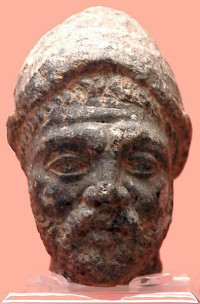Arsaces XVI
Arsaces XVI: little-known Arsacid king during a brief "dark period" in the history of the Parthian Empire (r.75-62/61).

After the long and succesful reign of the Parthian king Mithradates II, his son Gotarzes I became king (91 BCE). His accession marks the beginning of what is called "the dark age" of Parthian history: we do not really understand who had power and who had not. In any case, Gotarzes had a rival: a relative named Sinatruces had revolted in Elam (93/92). It appears to have taken Gotarzes quite some time to remove the rebel and several months after his final victory in 88/87 BCE, his own reign came to an end.
He was succeeded by Mithradates III, who appears to have been king for seven years, but lost a war (and the Parthian possessions in Atropatene, Arbela and Nineveh in Adiabene, Gordyene, and Osrhoene.note) against Tigranes II of Armenia. As a consequence, a new pretender rose: Orodes I (spring 80 BCE), who was sole ruler for several years but did not survive a crisis in about 75 BCE.
In that year, Orodes' coinage comes to an end and new coins were minted by an otherwise king, provisionally called Arsaces XVI by scholars. The return of Sinatruces, a former rebel king, may have been the trigger that led to the demise of Orodes; alternatively, the end of Orodes may have been the cause of Sincatruces' return.
It seems that Arsaces XVI started his career in Parthia itself, perhaps as early as 77 BCE, expelled Orodes from Susa in 75, and captured Babylon. Being in control of a large part of the Parthian Empire, he got involved in the Third Mithridatic War (73-63) between on the one hand the Roman Republic and on the other hand Mithridates VI Eupator of Pontus and his ally Tigranes II of Armenia. It seems that the latter requested Parthian assistance, which Arsaces granted on condition that the lost territories in Atropatene, Adiabene, Gordyene, and Osrhoene were returned.
The Roman general Lucullus also sent envoys, but the negotiations were completed by the next king, Phraates III, as son of Sinatruces. It seems that Arsaces XVI had lost control of the western part of his empire after 67 BCE, although he still minted coins in 62. The accession of Phraates, who was uncontested sole ruler of the Parthian Empire until 58/57 BCE, is the end of the "dark period" in Parthian history.
Note
The chronology of the Arsacid kings of the Parthian Empire is less well-understood than, for example, the sequence of Seleucid and Ptolemaic kings or the emperors of Rome. This information is based on the researches by G.R.F. Assar, as published in "Iran under the Arsakids, 247 BC – AD 224/227" in: Numismatic Art of Persia (2011).